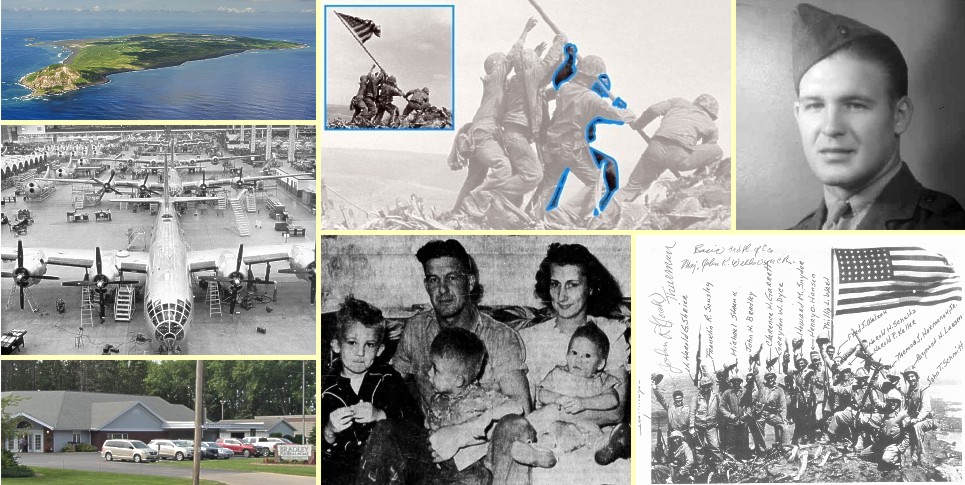Kansas Snapshots by Gloria Freeland - August 9, 2024
A piece of "Pie"
In literature and reality, we like our heroes bigger than life and for there to be a clear dividing line between good and bad. But
I think the following story is best viewed with an open mind that avoids choosing heroes and assigning motivations.
The starting point is February 1945 - the latter days of World War II. German surrender is still a few months away, but the
handwriting is on the wall. Eisenhower's forces were completely occupied in Europe, but the focus in Washington was the defeat of
Japan. U.S. forces continued to island hop ever closer to the Japanese homeland.
The B-29 was the only bomber with sufficient range to operate from islands suitable for bases. For months, the planes built at
Boeing's Wichita plant had been plagued with problems. But by the late spring of 1944, the "Battle of Wichita," as the effort
to address them was called, had been won. The solution for the notoriously undependable engines was to replaced them every few
missions. In the summer of 1944, the Mariana Islands were captured. Air fields there would put the Japanese homeland within the
plane's reach.
But the 12-hour flights were almost all over water. Approximately half way, there was the small island of Iwo Jima. It was heavily
defended, yet capturing it meant the Japanese wouldn't be able to use it as a base to attack the stream of B-29s coming and going.
It would also be helpful for planes that developed a problem. They might be able to reach the island's landing strip, or, if they had
to ditch in the ocean, rescue forces would be much closer.
Capturing Iwo Jima proved to be a bloody affair and Americans at home were losing their appetite for war. Financing the fighting was
not done with taxes, but with money raised through bond drives, which depended on Americans voluntarily purchasing them. The
Roosevelt administration had to find something to reignite the country's earlier passion.
The flag-raising photo on Iwo Jima's Mount Suribachi answered that need. The original flag raised on the morning of February 23
was small and unlikely to be seen at much distance, so the decision was made to raise a larger one. The second raising occurred when
Associated Press photographer Joe Rosenthal was present and his photo resonated.
When the government realized how inspiring the photo was, President Roosevelt ordered the flag raisers home to serve as
flesh-and-blood heroes at bond-selling drives across the country. By this time, three of the men had died in fighting.
Corpsman John Bradley was recovering from injuries. After the war, he bought a funeral home in Antigo, Wisconsin. A distant relative
of husband Art had been an owner. We passed it every year on our annual trek to our cottage, prompting us to think of that photo. Clint
Eastwood's 2006 movie "Flags of Our Fathers" was based on the book by John's son.
However, the passage of time and the rush to later identify those involved meant errors were made. John Bradley was not
one of the men in the photo. Nor was Rene Gagnon, another who was incorrectly identified.
It's tempting to believe Bradley or Gagnon were trying to capture a bit of glory by never coming forward and setting the record
straight. But all of the men had been present and had played a role - bringing the larger flag, finding a pipe to mount it on,
piling rocks about the base, removing the smaller flag, and so on. Bradley did participate in raising the initial flag. The dangerous
mission probably felt a bit foolish to the men risking their lives. Remembering exactly who did what was unlikely to have been a
priority.
A story circulated that someone later questioned the identifications, but the names had already been released. Those in command made
it clear that the bond drive was the important thing and quibbling over details might detract from those efforts, so nothing further
was to be said about it ... ever!
Amateur historians Eric Krelle of Omaha, Nebraska, Stephen Foley of Wexford, Ireland, Dustin Spence of Sacramento, California
and Brent Westemeyer of Johnston, Iowa were responsible for finding the truth. Initially they worked separately, but later
collaborated.
While I had heard about this story, it wasn't until traveling I-80 a few days ago, it became a bit more personal. I saw a sign that
I thought said "Brooklyn, Home of Harold 'Pie' Keller." Corporal Harold Keller, along with Private First Class Harold Schultz, were
the two men who were actually in the iconic photo, but had been misidentified.
Before the war, Keller had become sick during a high school football game he was playing in and purged himself in front of the fans
of the pie he had eaten earlier. That incident produced a nickname that stuck.
He had worked for a telephone company, but when the war began, he enlisted. While home on leave, he married local Ruby O'Halloran.
After the war, they raised a family while he worked at the telephone company and several other jobs. For 30 years, Keller
was a volunteer fireman, part of the time serving as chief. Like Schultz, he mentioned to family members about his flag raising
involvement, but didn't see his official omission as important.
His daughter Katie later tried to get him to talk about his war experiences which involved several other major battles, including
being shot by a sniper. But he rarely agreed. She said it struck her that while many men came back suffering from PTSD, her father
was completely normal.
Keller died in 1979 of a heart attack at age 57. At the time, his only claim to fame was being a quiet family man who had been the
focal point of an embarrassing incident at a football game many years before.
